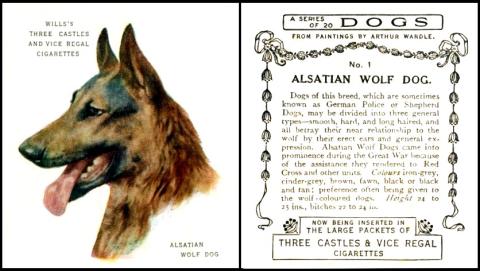
This card was selected because it called what we know as the German Shepherd an Alsatian Wolf Dog. So I wondered whether the card`s writer knew something I did not - and whether the Alsatian was descended from the wolf.
So the first thing I found out is that it was specifically bred, in Germany by Max Emil Friedrich von Stephanitz, a German cavalry officer, and student at the Berlin Veterinary College. He wanted to breed an intelligent working dog, to a standard, because at the time there was a whole mixture of dogs used to herd livestock, and he had a dream of making one breed that would represent a German Shepherd Dog. One day he met Horand von Grafrath at a show, and liked him immensely; a deal was done and Horand therefore became the ultimate descendent of almost every dog of his type since. He even has a wikipedia page!
The dogs soon attracted the attention of other people, and trials of them being used for law enforcement added another talent to their name. They were also used in the First World War as guard dogs and messengers. Some dogs were even brought to England by returning soldiers, but during and immediately after the war there was bad feelings against Germany, and so the name of the dog was changed from German Shepherd to Alsatian or Alsatian Wolf Dog.
Now our card comes from the late 1920s, but still the Germanic connection had not been resumed. Though oddly the text calls them "German Police or Shepherd Dogs". But the strangest thing of all is that it was only officially renamed as a German Shepherd Dog by the Kennel Club in 1977.
Despite there being no actual wolf in our dog, there is another intriguing snippet to share, because in 1935 an experiment was made by introducing a male German Shepherd to a female grey wolf from Siberia. There were puppies, and these started a breed called the Sarloos Wolf Dog, named after the breeder. This work is still ongoing, and further cross breeding has taken place. It is also recognised as a Kennel Club breed in Holland, its country of origin
This is an interesting set too. Our original Wills reference book catalogues it as part of a group listing, as :
DOGS (1927/28) - Heads. From paintings by Arthur Wardle. Large cards, size 70 x 63 m/m. Fronts printed by letterpress in colour. Backs in grey, with descriptive text. Issued in Australia, 1927-28. Similar series issued by Player (home issues, 1926 and 1928).
185. 20. "A Series of 20"
A. "Wills`s World Renowned Cigarettes" back and front. No Album Clause. Fronts "linen" surface.
B. "Wills`s World Renowned Cigarettes" back and front. With Album Clause. Fronts "linen" surface.
C. "Three Castles & Vice Regal Cigarettes" back and front. No Album Clause. Semi-glossy fronts.
186. "2nd Series of 20" "Wills`s World Renowned Cigarettes" back and front. With Album Clause. Fronts "linen" surface.
The John Player sets to which this refers are "Dogs Heads - from paintings by Arthur Wardle". These are a standard sized home issue set of fifty cards, a standard Irish issue split into two series each of twenty-five cards that for some reason does not mention the artist, and two large sized issues each of twenty cards. And Arthur Wardle also did a set of "Dogs - Full Length" for John Player, which was issued as a standard sized home issue set of fifty cards, a standard sized home issue set of fifty transfers, and a large sized set of twenty-five cards.
Now because our set and its variants were all issued in Australia, they are kept together in the World Tobacco Issues Index, where they are listed as :
DOGS. Md. 70 x 62. Heads, from paintings by Arthur Wardle. Nd. See W/185-6
1. "A Series of 20"
A. Front "Wills`s World Renowned Cigarettes". Back (a) with (b) without album clause.
B. Front "Three Castles & Vice Regal Cigarettes".
2. "2nd Series of 20" Front "Wills`s World Renowned Cigarettes"
They are pretty hard to locate in the updated version of this book, but they are under section 4C, and the text is identical to that immediately above.
